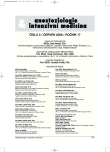Surfactant – use in adult patients
Authors:
D. Romportl; A. Hodek; M. Krečmerová; M. Pelichovská; K. Cvachovec
Authors‘ workplace:
Anesteziologicko-resuscitační klinika 2. LF UK a Fakultní nemocnice v Motole, Praha
Published in:
Anest. intenziv. Med., 17, 2006, č. 3, s. 176-180
Category:
Intenzive Care Medicine - Comprehensive Report
Overview
Surfactant is a complex surface-active substance, consisting of lipids and proteins, which lines the surface of terminal bronchioles and alveoli of mammalian lungs. It is responsible for maintaining essential biophysical and immunological functions of the lungs. Surfactant impairment is common in many pathological situations, leading to deterioration of pulmonary function. These facts have been known for about 50 years and since then we have been trying to develop effective treatment based on a natural or synthetic surfactant. In clinical practice, the use of surfactant has been well established only in newborns. In adults, the greatest experience with surfactant treatment has been gained in patients with acute respiratory distress syndrome (ARDS), the results however, being controversial. Recently new, narrower indications for surfactant use have emerged, bringing the first promising results.
Key words:
surfactant – ARDS
Labels
Anaesthesiology, Resuscitation and Inten Intensive Care MedicineArticle was published in
Anaesthesiology and Intensive Care Medicine

2006 Issue 3
Most read in this issue
- Surfactant – use in adult patients
- A comparison of haemodynamic changes using thoracic epidural anesthesia versus standard balanced anaesthesia during on-pump coronary artery bypass grafting
- Assessment of regional tissue perfusion by indicator microdialysis technique
- Assessment of performance of NMT stimulators used during anaesthesia in the Czech Republic
